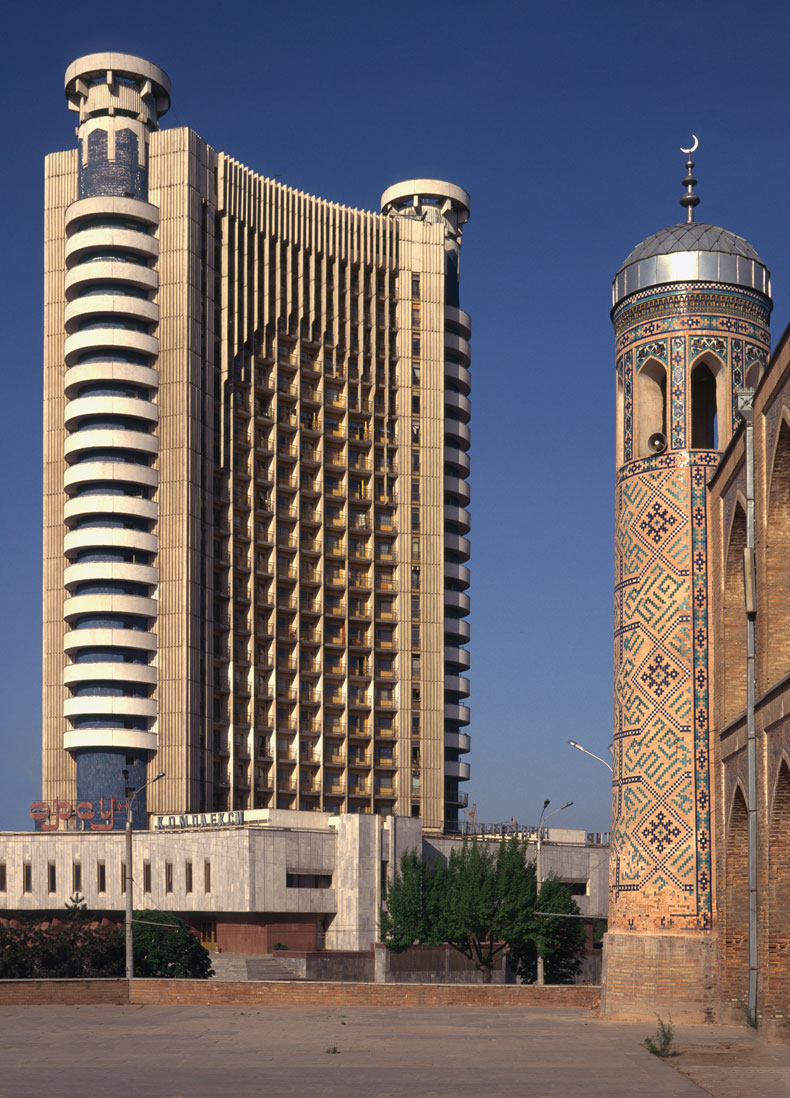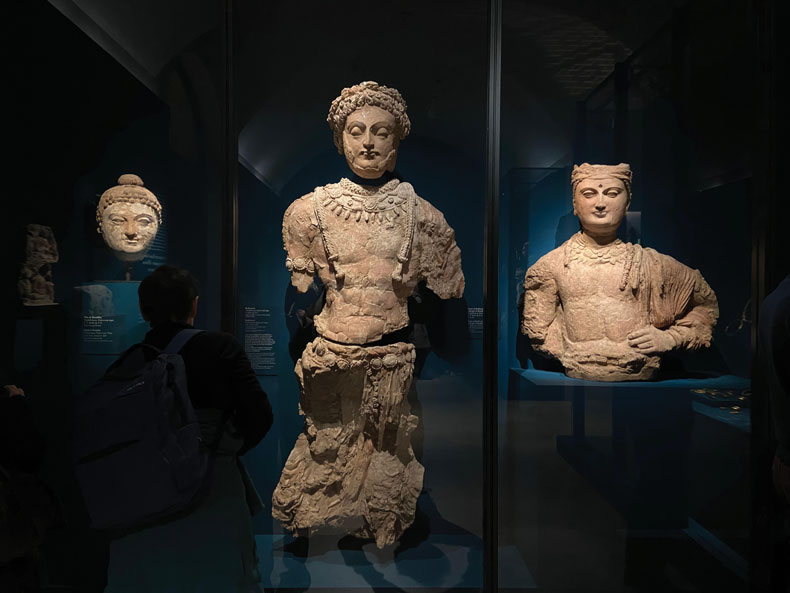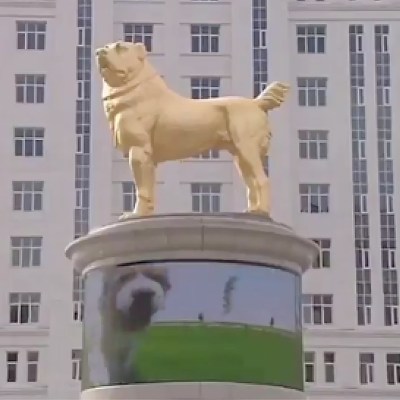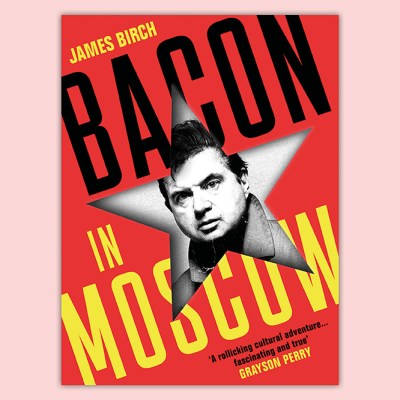From the November 2023 issue of Apollo. Preview and subscribe here.
On 26 April 1966, an earthquake devastated Tashkent, capital of Soviet Uzbekistan. With its epicentre just a few kilometres below the centre of town, the quake flattened whole neighbourhoods of the one-storey, mud-brick dwellings that characterised this oasis-city, on what had once been the Silk Road, and which was now the largest city in the Central Asian republics of the Soviet Union. Up to 95,000 homes were destroyed, and hundreds of thousands made homeless.
The disaster is etched into the fabric of the place as well as the collective memory of its inhabitants. In some ways, the earthquake has become the foundation myth of the city that Tashkent has become today. But today, Uzbekistan and its capital are trying to open up to the world. Through tourism, business and an effort to emerge as a major cultural player, the country is leveraging the ancient and the modern to stake its claim on the global map of the arts.
In the aftermath of the earthquake, Sharof Rashidov, First Secretary of the Uzbek Communist Party, outlined a sweeping vision for the future. Over the rubble of the old town with its warren of streets and network of close-knit ‘mahallas’, or neighbourhoods, would rise a new Soviet capital that combined socialist modernity with Uzbek heritage. A metropolis of pre-fab apartment blocks adorned with Central Asian mosaics, of covered markets under vast blue domes that dwarfed their inspirations in Samarkand, and of a metro to rival Moscow, but with added space-age flair.
Rashidov left behind a monumental and eclectic capital: huge modernist edifices, as if imported from Chandigarh, abut what remained of the old town. Almost playful pavilions and public buildings in what might be described as ‘Timurid Futurism’ grace the parks and boulevards that defined the centre of the new city and carried on into the metro below; the endless blocks of tile clad apartments that now house most of the city’s 2.4m inhabitants march out towards the mountains. This mélange created an aesthetic and a built legacy now known by the term ‘Tashkent modernism’, though Tashkent post-modernism would be just as applicable for many of the buildings.
The Chorsu Hotel and the Kukeldash Madrasa in Tashkent, Uzbekistan. Photo: Eitan Simanor/Alamy Stock Photo

As with all foundation stories, it pays to not look too closely at the facts. ‘The myth about the terrible earthquake of 1966 is a little exaggerated,’ says Sasha Fedorov, an activist and urban preservationist behind the popular @tashkent_modernism Instagram account, which has done much to popularise the city’s unique urban environment around the world. ‘The country’s leadership wanted to renovate the capital. The authorities took advantage of the situation very skilfully.’ Indeed, some estimates say just 15 people died in the earthquake (‘mostly heart attacks,’ says Fedorov) and pictures show bulldozers demolishing what appear to be structurally sound buildings in the aftermath. It was the earthquake that allowed Rashidov to realise his vision of what he wanted a modern Uzbekistan to look like.
Forty years after Rashidov’s death and the promotion of ‘Tashkent modernism’ is part of another programme to modernise the country, this time with culture at its heart. ‘Arts and culture is one of the biggest elements in a bigger strategy: that of developing the country,’ says Gayane Umerova, the executive director of the Art and Culture Development Foundation (ACDF) of Uzbekistan, a powerful government body that has muscles and the money to get things done.
With a global reassessment of post-war 20th-century architecture well underway, the ACDF are aware that much of the architecture of Tashkent is now cool. And it wants it to enjoy this moment in the sun. ‘This is exactly what we are focusing on now,’ Umerova says. In October, ACDF hosted a conference called ‘Where in the World is Tashkent’, devoted to the city’s modernist buildings. Rem Koolhaas was invited as the keynote speaker, along with historical preservationists from around the world, ‘to help us with the strategy. To understand how it’s done overseas’, Umerova says. As part of this initiative, a system to list significant buildings is being established, along with a design code. The aim is to have Tashkent’s modern buildings inscribed as a UNESCO World Heritage Site, along the lines of Brasília or Tel Aviv.
Plans for a UNESCO bid and proper criteria for protecting buildings are welcome to Fedorov, who reels off a list of modernist masterpieces that have already fallen to the wrecking ball: restaurants, public baths, museums. These have largely been replaced with cookie-cutter glass and steel towers – international hotels and shopping malls distinguished only by the fact that they could be found anywhere in the world. By the time ACDF has developed its preservation strategy there may be little left to show the UNESCO assessors. The iconic Chorsu Bazaar, one of the more extraordinary buildings to come down to us from the USSR, a huge covered market under a vast concrete dome covered in turquoise Timurid tiles and surrounded by a post-modern rendition of the bazaars of ancient Transoxania, is slated for a ‘renovation’ that is likely to do massive harm to the complex. The brutalist Chorsu Hotel, just next door, also looks likely to be demolished.
However, it seems a corner may be about to be turned. In September one of the city centre’s finest buildings, the former Sharq printing house, was put up for auction – which would almost certainly have led to its demolition. With 16 storeys in gleaming white and a vast clocktower at one end, it feels almost Mediterranean, and its loss would have been a major impoverishment of the cityscape. Fortunately, the auction has now been cancelled, and it appears that the ACDF’s attention to Tashkent modernism is likely to save at least some buildings.
Installation view of ‘The Splendours of Uzbekistan’s Oases’ at the Musée du Louvre, Paris, in February 2023. Photo: Franck Legros/Alamy Stock Photo

The promotion of modernist architecture is only a part of a bigger rebrand for the country, whose president, Shavkat Mirziyoyev, talks of a New Uzbekistan, one that is more open to the outside world, and – tentatively – more liberal at home. Mirziyoyev took over in 2016 from Islam Karimov. Karimov’s 27-year-long rule was monstrously oppressive, even by the standards of post-Soviet Central Asia. Peasants were compelled to bring in the cotton harvest for no pay, artists were harassed. Dissidents, especially Islamists, were routinely tortured and worse.
Mirziyoyev, though he was Karimov’s prime minister for many years, has made a break with the past and has brought forth, if not a liberal paradise, an Uzbekistan vastly more open and optimistic. He shuttered the notorious Jaslyk prison containing the old regime’s torture chambers. He has encouraged tourism and opened the country to foreign investment. Muslims can worship much more freely, and the country has become a refuge for opposition-minded Russians.
Mirziyoyev even gave government money to establish a techno music festival in the ex-seabed of the Aral Sea (with 45-degree Celsius days and minus-five-degree nights, along with a constant wind blowing poisonous dust from the old sea floor, the festival has since been relocated. In spite of the teething problems it is said to be the best party in Central Asia). Through the ACDF, Mirziyoyev has taken a big bet on culture, making it a central pillar of the New Uzbekistan project.
The foundation is also behind a series of international exhibitions of the greatest hits of the Silk Road – in the Louvre, the James-Simon Gallery in Berlin and soon, Umerova says, in the British Museum. These collaborations have been made possible by the repealing of a law that forbade Uzbekistan’s museum exhibits being lent abroad, so it is the first chance for most people in the West to see Uzbekistan’s extraordinary antiquities. Prominent in these exhibitions are Sogdian frescoes of kings, tigers, and elephants. Pointing towards the time when Buddhism was the main religion of Central Asia. The frescoes look almost Indic, while the giant statues of stone and adobe point to the legacy of Alexander the Great.
As well as giving the world a glimpse of the country’s ancient treasures, the ACDF also wants to look to the future. It has bold ambitions to foster new talent: a Centre for Contemporary Art is being built in a pre-Revolutionary tram depot in the centre of Tashkent, and a residency programme for artists is being established in a disused madrasa in the old town. Both are being built by Studio KO, which designed the Yves Saint Laurent Museum in Marrakech. In 2022, Uzbekistan participated at the Venice Art Biennale for the first time.
Installation view of the Uzbekistan Pavilion at the Venice Art Biennale in 2022. Photo: © gerdastudio – Giorgio de Vecchi/Giulia di Lenarda

Although the government is pouring resources into these projects, many who work in Uzbekistan’s tiny, pressurised, independent cultural sector wonder who the New Uzbekistan is meant to benefit. ‘It’s not about the people,’ argues Timur Karpov, a documentary photographer and film-maker, who is critical of the government. ‘Culture does not belong to the people, it belongs only to the authorities, and they can do whatever they want.’ For all the money going to the new Centre for Contemporary Art, Karpov points out that the small number of existing contemporary artists in Uzbekistan (‘There are like three or four in the whole country’) receive no government support.
In some ways, it is hard to argue with Karpov’s critique. In spite of Mirziyoyev’s reforms, Uzbekistan is definitely not a democracy. He received 87 per cent of the vote at the last election. There is no political opposition. It is tempting to see the efforts of the ACDF as that of an authoritarian regime engaging in culture-washing and jobs for the boys.
But, when you see the young Uzbeks working to make the Centre for Contemporary Arts a success, this criticism seems a little unfair. Many are alumni of Tashkent’s Art Academy, an institution so conservative that students are required to wear uniform (‘We were thinking of modernising the school, but then we realised that it’s better just to do something on your own,’ Umerova says. ‘In two years’ time we want to open our own school.’) The Centre is beginning to work with local talent, sponsoring lectures by curators such as Normurod Negmatov from Samarkand – and the residency in Tashkent is designed to give local artisans international training and exposure. International partnerships are designed to show Uzbekistan how to foster a creative sector. ‘We want to learn how to work with artists, how to give them more freedom,’ Umerova says. ‘We want to give them money for education, give them places for art residences.’
The state-sponsored cultural push in Uzbekistan is a top-down project in a country that does everything in a top-down fashion. Like the remaking of Tashkent after the earthquake, it is a conscious effort to enact a vision of a modern, forward-looking country (though not necessarily a liberal, democratic one). Possibly, like Tashkent itself, it could be many years before it is widely appreciated, but the attempts are likely to produce some interesting results.
From the November 2023 issue of Apollo. Preview and subscribe here.


